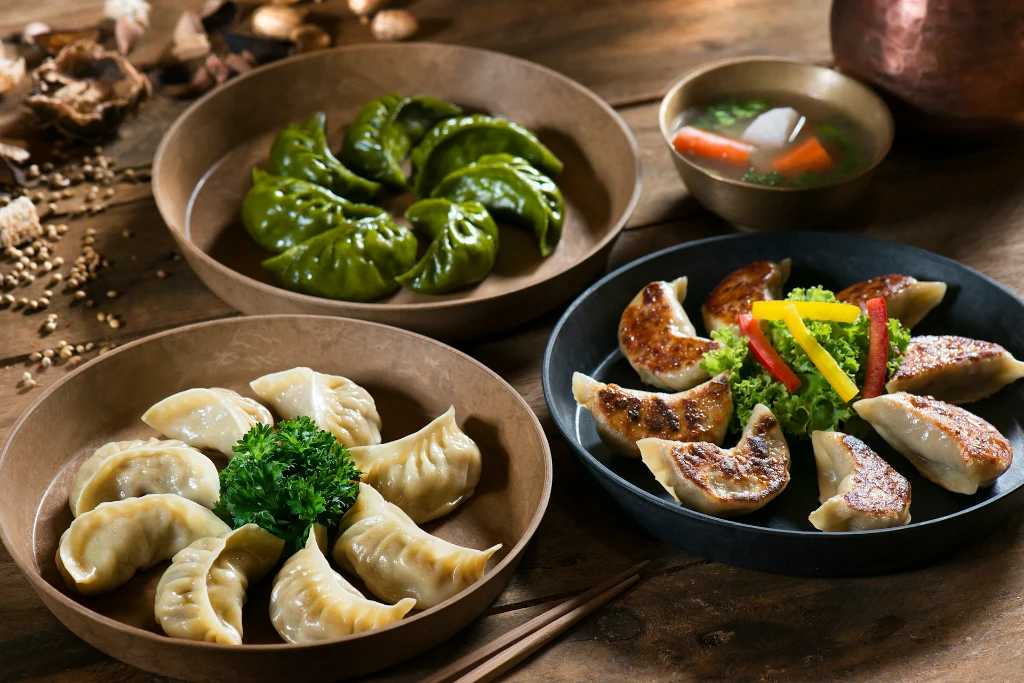Nepal is a small gem of a country in the Himalayas, rich in culture, tradition, and culinary delight. The Momo is one of its incredibly tasty treat gift to the world. In Newari, one of Nepal’s oldest languages, ‘mome’ means cooking by steaming. There are many varieties of dumplings in the Asian culture, but this one is unique to the Newar community. A hearty dumpling that originated from the scenic valleys of Nepal, this delicacy has stolen hearts and conquered taste buds across the globe.

The Origin
The origins of Momo are steeped in Nepalese history. It’s believed that the Newar community, known for their gastronomic expertise, introduced Momos. Yomari, another popular Nepalese dumpling, influenced their creation. It, too, is made from rice flour and filled with sweet substances. Yomari’s influence is clear in the shape and filling technique used in making momos. Momos were initially called “ma ma” or “mamcha” in Newari. Historians believe a Newari princess married to a Tibetan king took the Momo beyond the Himalayas.
These days, momos are a popular lunch alternative and popular street food. It is also popular at family and friends gatherings. It is something that brings together Nepalese all over the globe.
Varieties of Momo in Nepal
The Newari community were mainly farmers, so while they used meat for specials occasion, vegetables were abundant. Similarly, momos is popular in both meat and vegetable varieties and there was a time I ate banana momos at bhrikutimandap with my friend. This still holds true, as you’ll find an array of Momo varieties to savor. Steamed Momo, the classic form, is a favorite amongst locals and tourists alike. Then there’s the Fried Momo, crispy on the outside and juicy on the inside. For those who love a bit of heat, there’s the C-Momo, tossed in a hot chili sauce.
The accompanying soup or sauce will also vary significantly from place to place. There’s just so much you could combine it with. Try momos from multiple places to suit your tastebuds. I’ve even had momos with mushroom soup and those were mighty delicious.
Momos abroad
Momos have also traveled far and wide, evolving in every region they touch. In India, you’ll find Tandoori Momos, cooked in a traditional clay oven. In Bhutan and Tibet, you’ll discover Momos filled with yak meat, a local staple.
In Nepal, Momos are more than just food; they are a symbol of togetherness and celebration. Be it a family gathering or a festive occasion, Momos are a family favorite.
Now, let’s dive into the world of Nepalese cuisine as I share two detailed recipes straight from my kitchen at my beloved restaurant.
Momo culture in Nepal
Lunchtime favorite
Momos are readily available in restaurants around the country. They are more common in the hilly region, as this is where the most cities with dense population lie. Momos are a hearty meal during lunchtime for many of its inhabitants.
Many people come to the city area for work and business, and many prefer momos for lunch time. You can find restaurants openly advertise their momos on their signboards and some even have a momo steamer outside. So everyone knows there are momos available in the restaurant. There are even restaurants that just sell momos and nothing else.
At lunchtime, these restaurants become packed with people waiting around for their lunch and momos are a crowd favorite. It doesn’t matter if you’re a vegetarian or meat eater, everyone gets their fill of the dumplings along with their friends and colleagues.
As a Family activity
Preparing momos requires many ingredients and multiple hands on deck. Restaurants and hotels are the usual places to find momos around the country. Besides the restaurants, we can find frozen momos in some marts. Usually cheaper than restaurants but needs your own preparation.
It is also a fun activity during family gathering. As anyone can take part in the cooking process, everyone joins in to make momos at home. One kneads the dough, someone mixes the filling with the spices, someone else gathers and cuts the vegetables and spices for the soup.
Once the dough and filling are ready, everyone gathers around the table to wrap the filling. Then one picks up the wooden rolling board to roll the dough into small, circular, flat shapes. Others pick up these small flattened dough and the filling with a spoon and wrap it into a momos. Adults who know how to wrap teach the kids how to do it. Children try to learn or make their own shapes.
Street Food
The street food culture in Nepal isn’t very old. Street food and especially night street food popped up in the last 10-20 years. Now big cities have a swarm of street food stands at general hubs around the city during the evening. People gather around while the street food vendor prepares food. You’ll find sausages, fried chicken drumsticks, skewered kebabs and other local delicacies. And street food won’t be what they are without momos to choose from.
I should note that the quality of momos in these street foods stalls vary significantly, so we recommend it to try it with a local if you can. They’ll know which stalls have the best quality and better tasting food so you don’t ruin your stomach. If you can’t find a local, try to seek some reviews on travel websites and forums.
Frozen momos
You can now find frozen momos at some local marts. They usually have around 50 momos along with frozen soup or chutney. You just have to take it home and steam it for a quick meal. These were quite popular during the 2020 covid quarantine. People couldn’t stay away from momos for too long and these were selling very well. You will need a steamer if you want to steam it, or you could fry them, or even heat it in the oven.
No matter how you eat your momos or how you combine it with, it is a must experience of your tastebuds. Momos and its varieties and combinations is a journey one that takes you through the lanes of Nepal’s rich culinary heritage. So, roll up your sleeves and get ready to bring the flavors of Nepal into your own kitchen!


